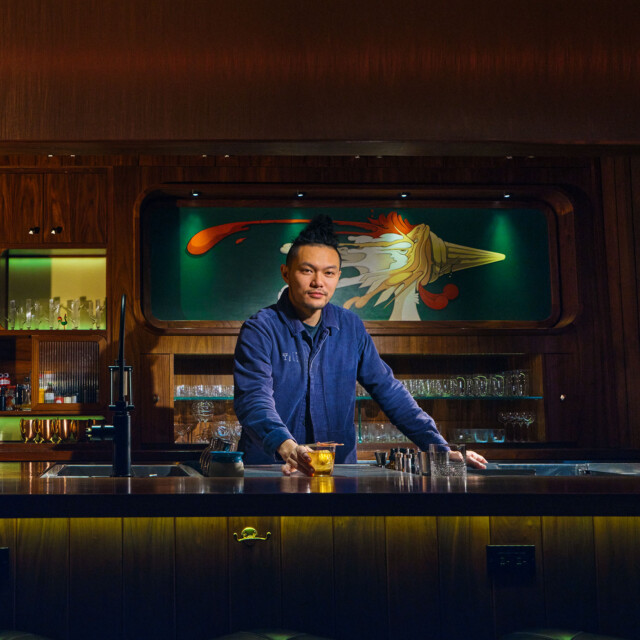There are a few tried-and-true methodologies from which delicious cocktails are born. There’s the scientific approach, from bars like Shinji’s, that utilizes the latest equipment and technology to painstakingly develop drinks until the delicious result can be replicated with exacting precision. Another perennial favorite is the culinary approach championed by Schmuck, where a deep well of ingredient knowledge and intense palate training leads to novel flavor combinations that are immensely satisfying.
Advanced historians like Garrett Richard from Sunken Harbor Club synthesize history from a variety of contexts and insert the learnings into cocktails. His work uncovering the secrets of classic American soda fountains and reimagining them in a boozy context has led to some truly compelling drinks. The most common method, however, and the best starting point for any new bartender, is historical — opening a book and replicating a classic recipe exactly as written, then moving on to swap ingredients in and out, Mister Potato Head-style, to create something new.
Every time I talk to a bartender and they make a cocktail for me it’s relatively easy to suss out the context that they’re operating within and their chosen methodology — most bartenders are also eager to tell you exactly what they’re doing and why. It’s a rare treat to come across a bar and a bartender operating outside those common constraints, but there is certainly nothing common about GN Chan and Double Chicken Please (DCP). GN’s unique background and novel approach to drink making generate some of the most compelling and quaffable cocktails I’ve had in recent memory. The approach extends beyond finished recipes to sub-ingredients as well — the way he implements fat-washing, in particular, has me completely rethinking the utility of the technique.
Uncommon Inspiration
Most cocktail bartenders at the highest level have a classic story of how they got into the business — they grew up cooking with family or found their way to it through a restaurant job or needed night work that would let them audition during the day. GN’s path into the industry couldn’t be more unexpected. “I got scammed,” he explains. “Someone took all my money, I went broke, and that’s the moment I went to a bar to ask for a job.”
Before that shocking, life-changing event, GN had been a street magician, served in the Taiwanese military, studied industrial design at university, and started a design studio with his best friend whose nickname is “Turkey.” His full name Chia-an sounds like GN when spoken aloud and “G” sounds like “Jī,” the mandarin word for chicken, so to his friends he became “Jī pái,” literally “chicken cutlet.” Years before entering hospitality and founding his world famous bar of the same name, the duo of bird buddies called their design business Double Chicken Please. Then he got scammed, his life turned upside down, and he started making drinks.
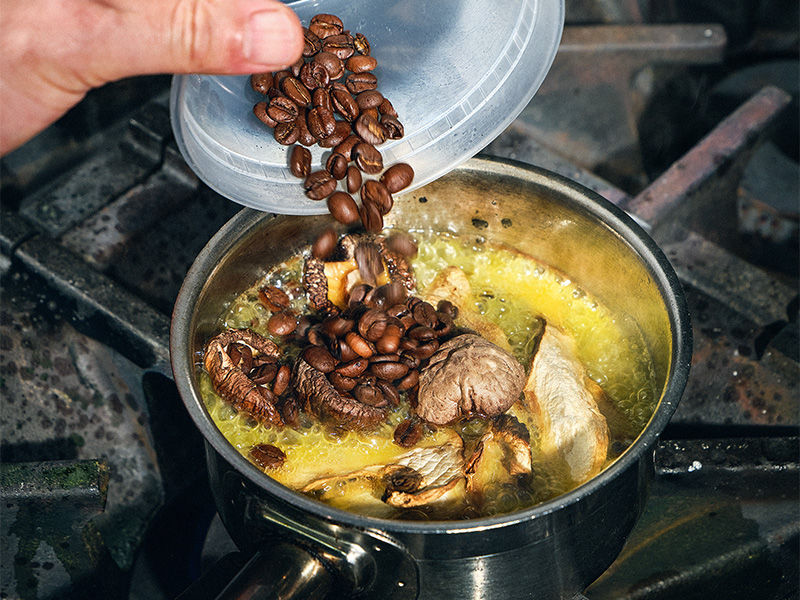
“So I basically got the job, but I lived in the bar, in the attic, for seven months, and that’s how I learned [to bartend],” GN says. After he became confident in his skills, and inspired by a conversation with a bartender visiting from Hong Kong who told him that New York was the city to be in for cocktails, he scraped together enough money for a one-way ticket from Taoyuan, Taiwan.
There were some seriously lean times for GN early in his New York days. He almost gave up and went back to Taiwan when he finally got his break — Shingo Gokan offered him a job at Angel’s Share. It was a host position, but with a chance to learn behind the bar. GN used his time at Angel’s Share to develop his signature style of drinks and cocktail development.
He builds his drinks like a designer, starting with the look. Wandering the magazine racks at the Union Square Barnes & Noble, searching for images that could become a jumping off point for a drink, was an early source of inspiration. If nothing from a particular magazine sparked an idea, he recalls closing the book, turning it 180 degrees, and reading it again. “Sometimes that triggers something. It’s all very visual,” he says. That approach remains true to this day. GN tells me that he’s more likely to be stimulated by “how something looks, a moment on the street, or a piece of glassware” to come up with a drink than any cocktail book deep-dive or spirits-tasting seminar.
A chance interaction with a guest at Angel’s Share inspired the “Appetizers, Mains, Desserts” food-as-drinks menu concept in The Coop — the bar-within-a-bar at Double Chicken Please that claimed the title “World’s Best Cocktail Menu” from the Tales of the Cocktail Spirited Awards in 2023.
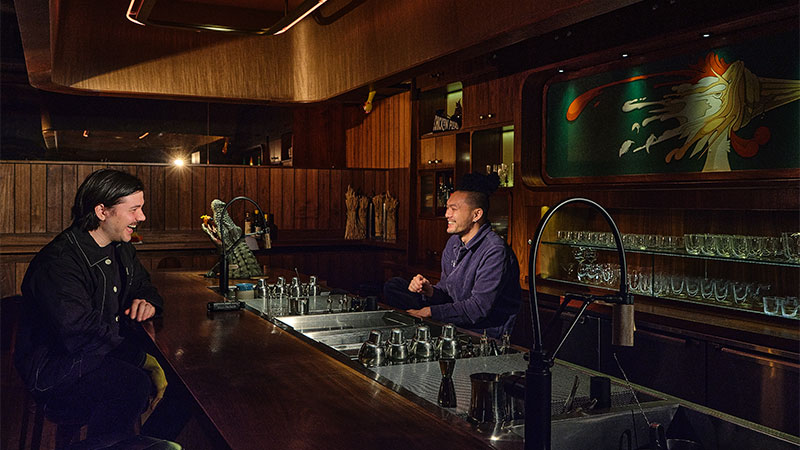
When a solo drinker came to the bar and couldn’t decide what to order, she told GN that she was waiting for lab results that would reveal whether or not she had cancer. Her head was in a million places other than at the bar. He took a moment to deal with the gravity of the situation and instead of the standard, “Well, what do you usually like to drink?” he asked, “What do you like to eat?”
The vibe shifted. It was no longer a conversation geared to get her mind off of a nightmare scenario, and turned into a chat about a source of joy. GN fixed up a beet salad-inspired cocktail — the bar happened to have fresh beet juice on hand at the time — and, as he puts it, “that’s how everything started.” He sees this as a way to connect guests to a drink through memory. Food is the perfect vehicle to tap into nostalgia and GN is a firm believer that “nothing tastes better than nostalgia.”
Accessing Memory Through Flavorful Fats
When I stopped into The Coop for a drink and to test GN’s nostalgia theory, I honed straight in on the Red Eye Gravy. During my time at Booker and Dax I was constantly hounding the cooks at Momofuku Ssam Bar — the neighboring restaurant with which we shared a kitchen — for country ham and the signature red-eye-gravy-inspired sauce they served alongside. Much to my delight, the drink is directly inspired by that very dish, or at least its creator. GN saw Episode 15 (“Smoke”) of David Chang’s season of “Mind of a Chef,” the terrific PBS series that chronicled the philosophies and strategies of famous food professionals. In it, Chang explored the classic American breakfast sauce consisting of coffee and ham drippings and reimagined it as a dipping sauce for sliced country ham. GN knew that he had to taste it and ultimately turn it into a drink.
So how does one take a meaty, funky, concoction like red eye gravy and transform it into a cocktail?
The problem, as GN saw it, was how to incorporate such rich flavors and have the final drink stay palatable. After choosing Irish whiskey as a base spirit, the next step was adding an unctuous mouthfeel. A direct ham fat-wash was too aggressive for his taste, so he turned to butter. But rather than perform a standard butter fat-wash, then add coffee and umami-rich flavors to the base spirit afterward, GN performed one of the most clever and deft applications of technique I’ve seen in ages and infused all the secondary and tertiary flavors into the butter first.
(Frankly, I’m upset I didn’t come up with this myself.)
To a saucepan with butter, GN adds a proprietary dried mushroom blend and whole coffee beans. He maintains the mixture at a simmer until the fat is redolent of both aromas, then strains it into a container with the whiskey. The flavors meld for hours before the container is transferred to the freezer so the coffee-mushroom-butter can solidify and eventually get strained off.
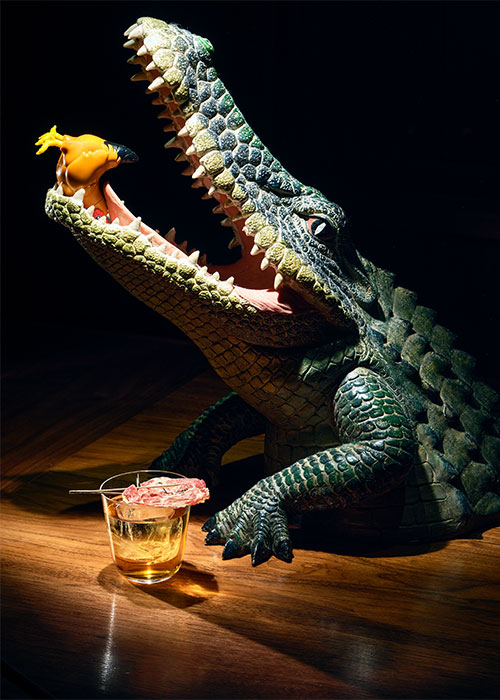
Asked on the benefit of infusing the butter over simply infusing the spirit, GN asserts that it all comes down to approachability. For example, DCP’s Butter Raisin Biscuit cocktail uses a more direct path to infusion. Raisins macerate in Pineau des Charentes for 24 hours, then the whole mixture takes a bath in an immersion circulator to intensify in flavor. The finished infusion is butter-fat-washed to add richness and body. The result is an in-your-face raisin flavor that works beautifully with the subtlety of the raisins, but a more forceful ingredient could become overpowering quickly.
Coffee and mushroom are certainly bold enough to take over a drink GN envisions as “rounded and nice,” so into the butter they go. The infused spirit is transformed into an Old Fashioned using a touch of vegetal sweetness from a house corn syrup, and nuttiness from nocino, a walnut liqueur.
For a visually stunning finale, a perfectly crisp chip made from a piece of microwaved coppa adorns the drink, adding a salty, meaty component that calls back to the original ham. It’s a phenomenal Old Fashioned, and the first drink to plunge into the joyous depths of my memory where I keep thinly sliced American ham and coffee sauce.
Compound Fat-Washing at Home
Infusing butter with flavor then using it to fat-wash a spirit can be done in just about every kitchen with no additional tools or ingredients necessary. I took inspiration from The Coop’s Butter Raisin Biscuit and made a more New York-coded version: The Cinnamon Raisin Bagel, Toasted, With Butter. It’s toasted-cinnamon-stick-infused brown butter married with overproof bourbon and stirred up with Pedro Ximénez sherry to lend a raisin note. I can hardly tell if it’s a bagel or a Manhattan.
Cinnamon Raisin Bagel, Toasted, With Butter
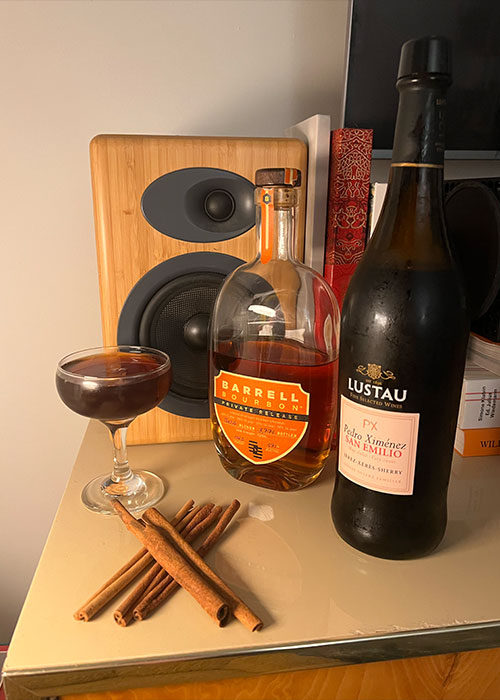
Ingredients:
- 2 ounces Cinnamon-Butter Bourbon**
- 1 ounce Lustau PX Sherry
- 1 dash Angostura Bitters
Directions:
- Add all ingredients to a mixing glass.
- Fill with ice and stir until the exterior of the glass is fully frosted over and the drink is properly diluted.
- Strain into a chilled coupe glass
- Enjoy!
**Cinnamon-Butter Bourbon:
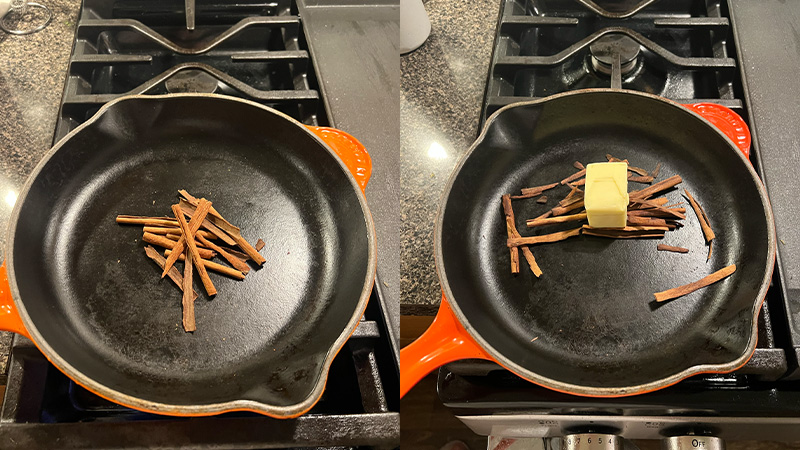
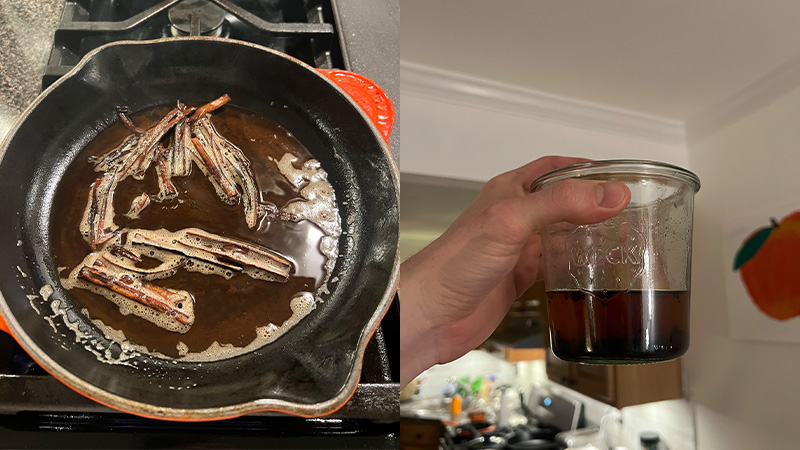
Ingredients:
- 10 grams cinnamon sticks, lightly crushed (about 5 sticks)
- 40 grams salted butter (about 2.5 tablespoons)
- 4 ounces overproof bourbon. (I used Barrel Bourbon Private Release — you’ll want something with a stout booze backbone to stand up to the rich, sweet sherry.)
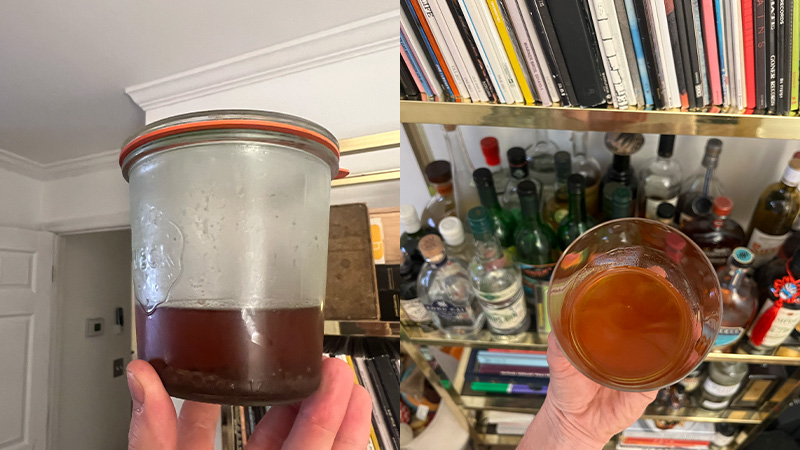
Directions:
- Add cinnamon sticks to a saucepan over medium heat. Stir regularly until they’re a shade darker and deeply aromatic.
- Add the butter to the pan and reduce heat to low. Melt the butter and bring to a simmer. Cook the butter and cinnamon until the butter is browned and your kitchen smells great.
- Strain the butter into a non-reactive, freezer-safe container and add the bourbon. Let sit for at least three hours at room temp to infuse.
- Move the container to the freezer until the butter is completely solidified.
- Strain off the butter.
- Store the cinnamon-butter bourbon in a glass bottle in the fridge.
This story is a part of VP Pro, our free platform and newsletter for drinks industry professionals, covering wine, beer, liquor, and beyond. Sign up for VP Pro now!
